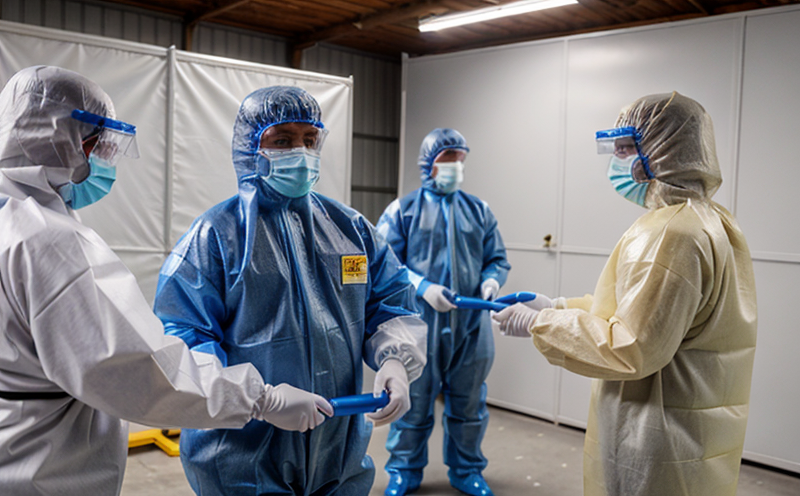Manikin based burn injury simulation of firefighter gear
The manikin-based burn injury simulation is a critical component in assessing the protective capabilities of firefighter gear. This testing method provides an accurate and reliable means to evaluate how well firefighting clothing protects the wearer from severe thermal burns, ensuring that firefighters can perform their duties safely under extreme conditions.
During this test, a humanoid manikin equipped with sensors simulates human response to heat by recording temperature changes at various points on its body. The manikin is subjected to controlled flame exposure for a specified duration, and the resulting thermal data helps determine the effectiveness of the gear in mitigating injury.
The test adheres to international standards such as ISO 13567-2, which specifies the method for evaluating resistance to thermal insulation performance. This ensures consistency and comparability across different manufacturers and models of protective clothing. The simulation not only tests the physical integrity of the gear but also evaluates its ability to dissipate heat away from the wearer's skin.
The test setup involves a controlled environment where the manikin is exposed to flames under conditions that mimic real-world scenarios, such as those encountered by firefighters during rescue operations. The flame exposure duration and intensity are meticulously calibrated to simulate the most challenging situations a firefighter might face. This allows for a precise assessment of how well the gear can protect against severe burns.
Post-test analysis involves detailed examination of the manikin's surface temperature readings, burn patterns, and other relevant data points. These metrics help identify specific areas where the gear may fail to provide adequate protection, enabling manufacturers to make necessary improvements. The results are reported in a comprehensive manner that includes graphical representations of heat distribution, time-to-heat-rise curves, and comparative performance indices.
This testing method is particularly valuable for quality control and R&D activities within the fire safety sector. It ensures that new designs and modifications to existing protective clothing meet stringent safety standards, thereby enhancing firefighter safety. The insights gained from this test are crucial in developing next-generation firefighting gear that offers enhanced protection against high-temperature hazards.
Benefits
- Achieves Regulatory Compliance: Ensures that the protective clothing complies with international standards, thereby reducing legal risks and ensuring market acceptance.
- Promotes Safety: By identifying potential weaknesses in firefighting gear early on, this test helps prevent injuries to firefighters during critical operations.
- Informs Design Improvements: The detailed insights provided by the manikin-based simulation allow manufacturers to refine their products based on real-world data.
- Enhances Reputation: Successful completion of this test can significantly boost a company’s reputation for producing high-quality safety equipment.
Why Choose This Test
The manikin-based burn injury simulation is chosen by many organizations due to its unparalleled accuracy and reliability. Unlike other testing methods, this approach simulates the actual conditions under which firefighters operate, providing a more realistic assessment of protective clothing performance.
One major advantage is that it allows for repeated testing, enabling manufacturers to iteratively improve their designs based on multiple rounds of evaluation. This iterative process ensures continuous enhancement and optimization of firefighting gear. Additionally, the test’s adherence to international standards such as ISO 13567-2 guarantees consistency across different batches and models, ensuring uniform quality.
Another significant benefit is its ability to highlight specific areas where improvements are needed. By pinpointing exact shortcomings in protective clothing, this testing method helps manufacturers focus their efforts on enhancing critical aspects of the gear. This targeted approach not only saves time but also ensures that resources are used efficiently and effectively.
The comprehensive nature of the test also offers valuable insights into the overall performance of firefighting gear, beyond just its thermal protection capabilities. It evaluates various factors such as breathability, durability, and comfort, contributing to a holistic understanding of the gear’s suitability for use in challenging environments.
Quality and Reliability Assurance
- Consistent Results: The standardized procedure ensures that every test yields consistent results, allowing for accurate comparison between different products and batches.
- Independent Validation: Third-party laboratories can conduct the test to verify compliance with regulatory requirements, adding an extra layer of assurance.
The manikin-based burn injury simulation is a cornerstone in maintaining high standards of quality and reliability within the fire safety sector. By adhering to strict protocols and international standards like ISO 13567-2, this method ensures that protective clothing meets rigorous performance criteria.
The use of advanced instrumentation and data analysis techniques further enhances the accuracy and precision of the test results. This not only upholds the integrity of the testing process but also fosters trust among stakeholders, including regulatory bodies, end-users, and the public at large.





